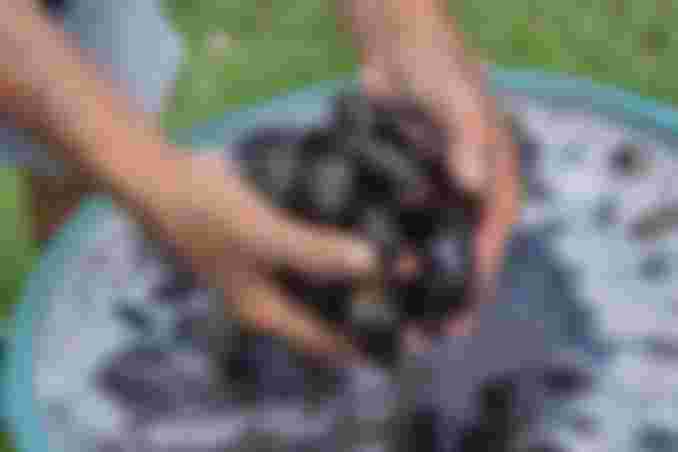Measurement of Physical Properties
The axial measurements, weight, geometric mean diameter and sphericity of the nuts and kernels and the thickness of the shells were among the physical properties studied. 30 nuts were used at each level of moisture content, and the same set of nuts were cracked to determine the shell and kernel dimensions. In terms of its length , width and height, the size of the Pili nut was expressed. The width can be difficult to discern from the other sides of the shell since the transverse cross-section of the nut is almost triangular. Measurements were carried out to overcome this problem when the widest and most convex side of the nut was facing the reference surface.

The nuts were carefully cracked using a c-clamp to obtain whole kernels in order to determine the measurements and weight of the kernels and the thickness of the shells. Both linear measurements were calculated with a precision of 0.02 mm and a resolution of 0.01 mm using a digital vernier caliper (Standard GageTM). A digital balance (OHAUSTM Precision Advanced GT4100) with a precision of 0.01 g and a resolution of 0.01 g was used to determine the weight of the nut and kernel. From the dimensions of both nuts and kernels, two parameters (geometric mean diameter and sphericity) were also obtained.
Processing Operations and Standards
Harvesting. Pili fruits in cluster do not mature at the same time, therefore, harvest only the ripened fruits. Harvesting matured fruits is done by priming or picking and a long pole, a cutter or knife and basket may be used. Harvested fruits are placed in baskets or sacks. If the pulp of the fruit is intended to be sold for food purposes, harvested fruit will be placed in a well aerated container to prevent softening of the pulp.

Pulp removal
Traditional manual depulping. Four methods of depulping are practiced. The first method is the hot water treatment (HWT). Heat the water in a vat until 60°-70°C. Put off the fire. Place fruits in the vat and stir constantly to keep its temperature uniform. Leave fruits for about 15-30 minutes to soften the pulp. Drain water. Cool fruits and peel manually. Pounding the fruits using a wooden mallet until the pulp is separated from the shell is another depulping method. It is the simplest and most economical since the depulped nuts are no longer washed and are directly dried under the sun. In commercial scale, the retting method is used where the fruits are soaked in tap water from 1-2 days until the pulp softens. In the fermentation method, fruits are kept in sacks or polyethylene bag and left from 1-2 days under shade to soften pulp. The pulp softens because of its moisture and higher temperature inside the sack.

Mechanized depulping. Various depulping machines were developed in recent years aiming to better the depulping process of pili. KOLBI is a manufacturing company in Naga, Camarines Sur selling postharvest and other agricultural machineries. The researchers conducted site visitations to places that use depulping machines by KOLBI. Common problems, regardless of machine model, were partial depulping of fruits and pili shell breakage due to the varying sizes of fruits. Shell fragments mixed in the pulp affects the oil extraction process.
Washing and drying. After depulping, wash the nuts in clean water to remove the slimy material adhering to the shell. During this process, discard all nuts that float. Floaters are either unfilled or devoid of kernel. After washing, nuts are dried under full sun for 2-3 days enough for pilinuts to be stored for at least a year. Nuts should not be dried for more than three days to avoid shriveling of kernels. During cloudy days, nuts may be dried longer for about 4-5 days.

Storage. Pili nuts can be stored either shelled or unshelled. Most processors place the nuts in clean sacks which have a capacity of about 50kg. Stack sacks in pallets and store in a well-aerated room. Sacks should not be in contact with the walls of the storage house to prevent contact with any moisture. A regular inspection prevents rat and insect infestation. Indigenous materials such as cardboard boxes are more durable and result in lowest number of rancid and shriveled kernels after a year of storage.
Shelling. Kernel is extracted manually. Cut the shell crosswise at the middle portion with the use of sharp bolo. After cutting the shell in two, remove the kernel carefully and place in a clean collection box or plastic basin. Great care and skill are required and the cutting stroke should be controlled to prevent cutting through the kernels.

Seed Coat Removal. The brown seed coat or testa sticks tightly to the kernel. To peel, blanch the kernels with boiling water for about three minutes and cool for easy removal of testa. Squeeze the kernels carefully to slip off the testa. The clean kernels are air-dried and packed in plastic bags prior to processing into various food preparation.






